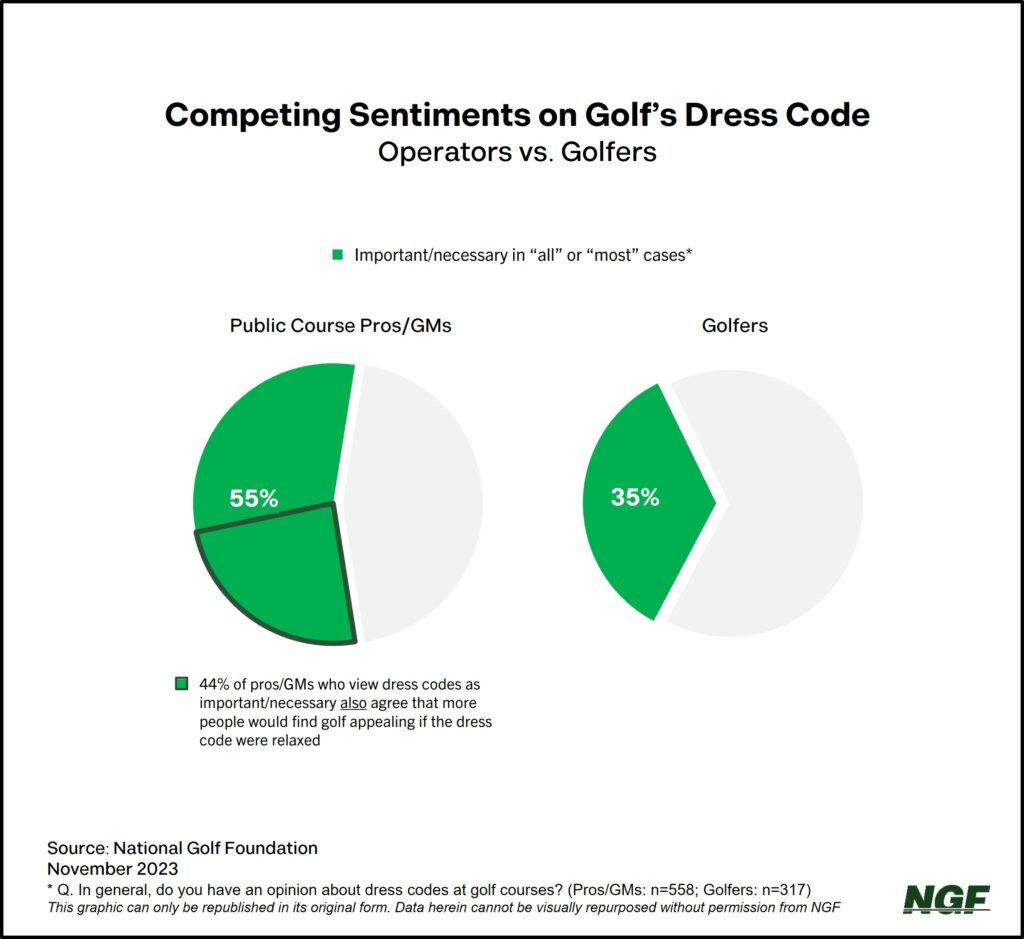The Business Case for Golf’s Dressing-Down
(
Did you know wearing a white lab coat has been scientifically proven to increase focus? That dressing elegantly enhances abstract thinking, which is essential to creativity and problem-solving?
What we wear matters, apparently. Emerging viewpoints in the world of science suggest that clothing can affect us in meaningful ways — our negotiating skills, athletic performance, posture, confidence, motivation, mood and hormone levels. Psychologists at Northwestern coined a term for this phenomenon: “enclothed cognition.”
Clothing is a powerful tool, and one of our most essential forms of self-expression and identity.
It’s encouraging, then, that golf is experiencing its own movement in self-expression through fashion. GQ Magazine recently chronicled the trend – likely to the surprise of those who, just a couple years ago, wouldn’t have put “golf,” “fashion” and “movement” all in the same sentence.
“Writing about the best golf clothing brands in 2023,” GQ notes, “is a much heartier and more entertaining endeavor than it would have been, say, a decade ago when the industry was still dominated by sportswear giants and conservative pro-shop brands.”
As exciting and opportune as this sounds, golf fashion is still regulated at the course level, to a certain extent at least, and we can’t ignore competing sentiments concerning the need for, and enforcement of, dress codes.
In a recent NGF survey of golf professionals and GMs at public golf facilities, almost 60% told us a participant dress code is necessary in “all” or “most” cases.
Necessary for what, though? Keiser’s College of Golf explains that dress codes “keep new and veteran golfers in line with the traditions of the game.” Yet there’s nothing in golf’s original or current rulebooks that stipulate appropriate attire.
So, is golf’s dress code a key competitive advantage, attracting those who seek a civilized and sophisticated recreational activity? Or is it more of a deterrent to growth? And does continued enforcement of strict dress codes at public golf courses expose a sort of self-sabotage through complacency? Is it possible dress codes are one of those damaging orthodoxies that our industry preserves without truly knowing why, and without realizing the costs (or gains), simply because “that’s the way we’ve always done it?”
Our research reinforces the conflict: 44% of the same course professionals who endorse dress codes in virtually all public golf settings also believe a relaxed dress code would make the game more appealing for more people.
Perhaps not surprisingly, they’re right. Almost 70% of prospective non-golfers believe a relaxed dress code would increase their likelihood to play on-course golf.
Golf’s dress policies are as much a business discussion as a philosophical one. Particularly when you consider that failure to achieve a level of comfort in the golf course environment remains a leading factor in customer attrition.
Perhaps we’re underleveraging the power of clothing and fashion.
Short Game.
"*" indicates required fields
How can we help?
NGF Membership Concierge

"Moe"
Learn From NGF Members
 Ship Sticks Secrets to a Hassle-Free Buddies Golf Trip
Ship Sticks Secrets to a Hassle-Free Buddies Golf Trip
Whether you’re the head planner of your upcoming buddies golf trip or simply along for the ride, we’ve gathered a few easy ways to keep everyone in your group happy.
Read More... Golf Course Turf, Soil and Water Quality Diagnostic Testing
Golf Course Turf, Soil and Water Quality Diagnostic Testing
As humans, we see our primary care physician on a regular basis to proactively evaluate our vital signs. Likewise, a superintendent should perform frequent diagnostic testing on their golf course.
Read More... Unlocking Distance: Launch Conditions and Angle of Attack
Unlocking Distance: Launch Conditions and Angle of Attack
We’ve long known that higher launch and lower spin is a powerful combination for generating consistently long and straight tee shots. A key factor in optimizing launch conditions, one often overlooked, is ...
Read More...




